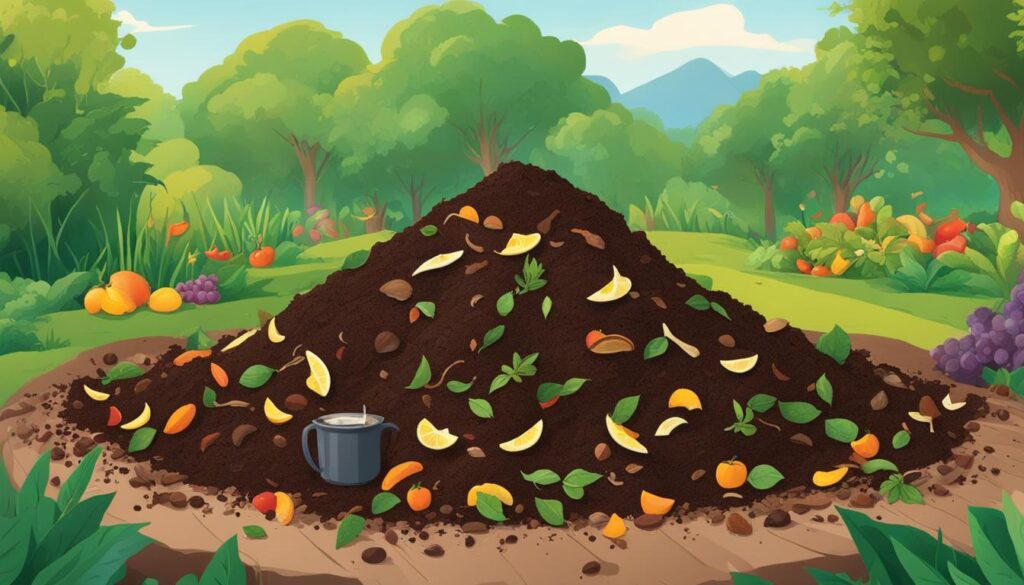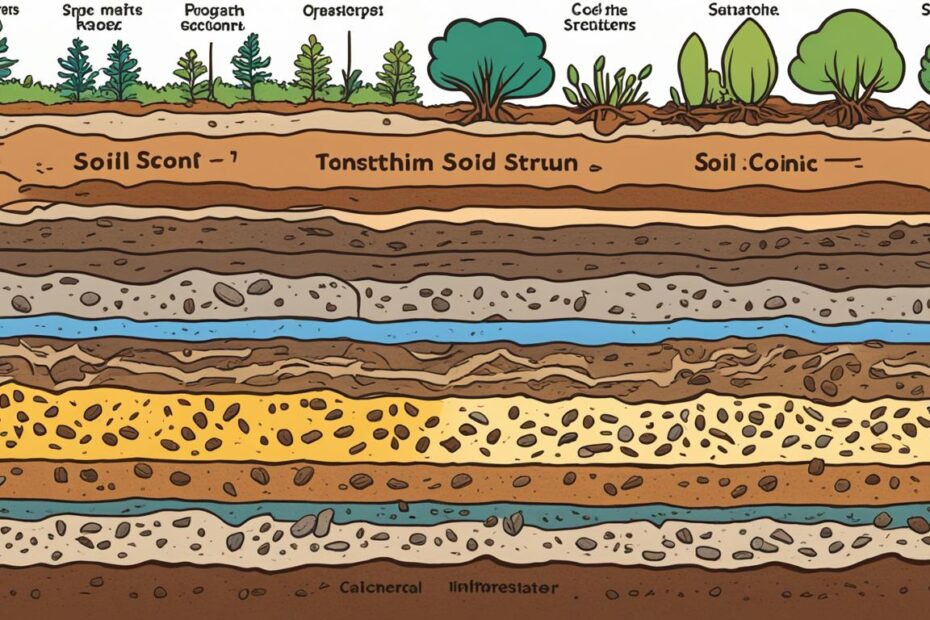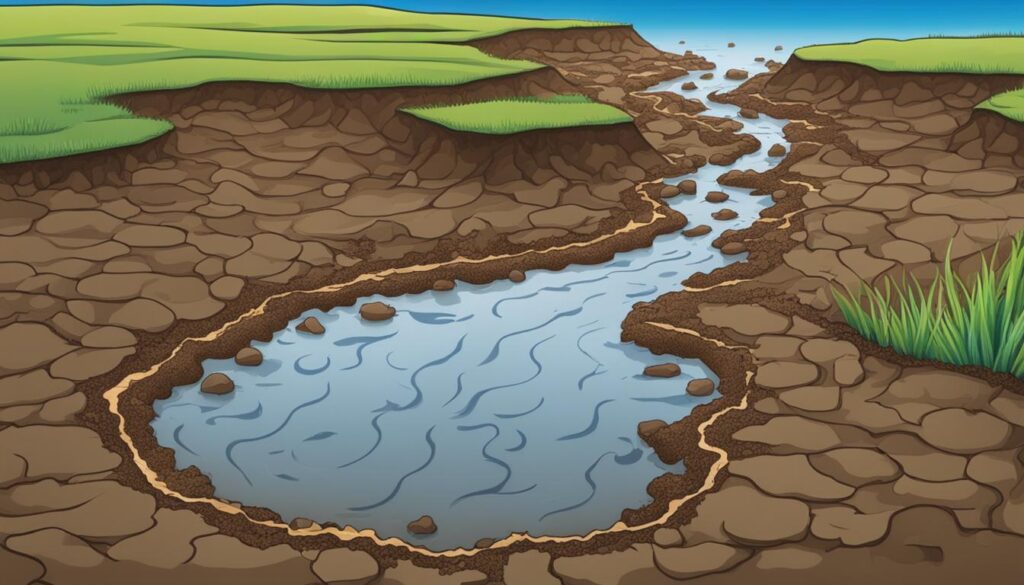Have you ever wondered what lies beneath the earth’s surface, nurturing the growth of plants and sustaining life? The answer lies in the soil, the earth’s vital skin. But what exactly does soil structure refer to and why is it so important? Let’s embark on a journey to uncover the secrets hidden beneath our feet and discover how soil structure is the key to unlocking fertile ground for a thriving ecosystem.
Key Takeaways:
- Soil structure refers to the arrangement and organization of soil particles into aggregates or clumps.
- It directly influences water infiltration, root penetration, and nutrient availability.
- Understanding soil structure is crucial for optimizing agricultural productivity and promoting sustainable land management practices.
- Improving soil structure can be achieved through organic amendments, cover cropping, reducing compaction, and crop rotation.
- Soil structure plays a vital role in plant growth, soil erosion prevention, water quality maintenance, and carbon sequestration.
The Components of Soil Structure
Soil structure is a complex arrangement of different components that work together to create a healthy and fertile environment for plant growth. Understanding these components is essential for optimizing soil health and promoting sustainable land management.
Soil Particles
The building blocks of soil structure are the soil particles themselves. These particles primarily include sand, silt, and clay, each with its own unique characteristics. Sand particles are the largest, followed by silt, and then clay, which is the smallest. The size and shape of these particles influence how they interact and bind together to form soil aggregates.
Aggregates
Aggregates are formed when soil particles bind together, creating larger clumps or clusters. These aggregates can vary in size, ranging from microaggregates to macroaggregates. They play a crucial role in soil structure as they create pore spaces that allow for root penetration, water movement, and nutrient exchange. Healthy soil structure is characterized by a balanced distribution of different-sized aggregates.
Organic Matter
Organic matter is a key component of soil structure. It is derived from decomposed plants and animals and acts as a binding material that helps hold soil particles together. Additionally, organic matter promotes the development of pore spaces within soil aggregates, improving water infiltration and enhancing the soil’s ability to retain nutrients. Organic matter also provides a source of energy for soil organisms, contributing to overall soil health.
Binding Agents
Binding agents further enhance soil structure by cementing soil particles and aggregates together. Common binding agents include clay minerals and microbial substances. Clay minerals have the ability to swell and shrink with changes in moisture, effectively binding soil particles together. Microbial substances, produced by soil microorganisms, also contribute to the formation and stability of soil aggregates.
By understanding the components of soil structure and their interactions, we can implement management practices that promote healthy soil and maximize agricultural productivity.
Factors Influencing Soil Structure
When it comes to soil structure, several factors come into play, influencing the arrangement and organization of soil particles. These factors play a crucial role in determining the quality of the soil and its ability to support healthy plant growth.
Soil Texture: The Foundation of Soil Structure
One of the key factors influencing soil structure is the soil texture, which refers to the relative proportions of sand, silt, and clay particles in the soil. These particles come together to form the foundation of soil structure. The size and distribution of these particles affect how they bind together, creating different levels of porosity and cohesion within the soil.
The Role of Organic Matter
Organic matter acts as nature’s adhesive, playing a vital role in enhancing soil structure. Organic matter serves as a glue, binding soil particles together and creating stable aggregates. It also helps improve soil fertility, water-holding capacity, and nutrient availability, making it an essential component for healthy soil structure.
The Impact of Soil Compaction
Soil compaction is a common issue that negatively affects soil structure. Activities such as agriculture, construction, or the use of heavy machinery can lead to compaction, which reduces the pore spaces within the soil. As a result, water infiltration and root penetration are hindered, limiting the soil’s ability to support healthy plant growth.
The Crucial Role of Soil Moisture
Optimal soil moisture levels are vital for maintaining an optimal soil structure. Both excessive moisture and drought conditions can disrupt soil aggregates and compaction. Adequate moisture promotes the formation and stability of soil aggregates, while the absence of moisture can cause the soil to crumble and lose its structure.
Understanding the various factors that influence soil structure is essential for promoting healthy soil and maximizing agricultural productivity. By managing soil texture, incorporating organic matter, preventing compaction, and maintaining proper moisture levels, you can create an environment that allows plants to thrive and grow strong roots.
CLICK HERE TO CHECK OUR RECOMMENDED PRODUCTSImportance of Soil Structure for Plant Growth
When it comes to plant growth and development, soil structure plays a crucial role. A well-structured soil provides the ideal environment for roots to thrive, encouraging optimal root development and maximizing nutrient uptake.
One of the key benefits of a well-structured soil is its ability to allow roots to penetrate easily. When roots can penetrate the soil without barriers, they can explore a larger volume of soil, absorbing nutrients and water more efficiently.
Water infiltration is another critical factor influenced by soil structure. A well-structured soil enables water to infiltrate easily, effectively preventing waterlogging. This is particularly important as excessive moisture can hinder root development and lead to plant stress. Additionally, a soil with good water infiltration capacity enhances drought tolerance, ensuring plants can access water during dry periods.
The arrangement of soil particles within aggregates is also essential for the health of plant roots. Aggregates create pore spaces that serve as pathways for water movement and air exchange. Adequate water movement facilitates nutrient transport to plant roots, while proper air exchange ensures an optimal oxygen supply for root respiration. Both water and air availability are crucial for healthy root development and overall plant productivity.
Soil structure also influences nutrient availability for plants. Well-structured soil promotes the movement and retention of essential nutrients, preventing their leaching and ensuring they are accessible to plant roots. This availability of nutrients directly impacts plant growth, vigor, and yield.
“Soil structure is the foundation for plant growth, providing the necessary conditions for roots to penetrate, water to infiltrate, oxygen to flow, and nutrients to be available. Without a well-structured soil, plants struggle to reach their full potential.”
To illustrate the importance of soil structure for plant growth, the table below summarizes how it affects root development, water infiltration, nutrient availability, and soil aeration.
| Soil Structure Benefit | Impact on Plant Growth |
|---|---|
| Facilitates root penetration | Enhances root development and nutrient uptake |
| Promotes water infiltration | Reduces the risk of waterlogging and improves drought tolerance |
| Creates pore spaces | Facilitates water movement and air exchange for optimal nutrient uptake and root respiration |
| Enhances nutrient availability | Improves nutrient uptake and supports overall plant growth and productivity |
A well-structured soil sets the stage for healthy plant growth by providing a favorable environment for roots. It ensures efficient root development, optimal water infiltration, enhanced nutrient availability, and adequate soil aeration. By prioritizing soil structure, you can enhance your plants’ vitality and maximize their growth potential.
How to Improve Soil Structure
Improving soil structure is essential for promoting healthy crop growth and maximizing agricultural productivity. Implementing various management practices can help enhance soil structure over time. Below are some effective methods to improve soil structure:
- Add Organic Amendments: Incorporating organic matter, such as compost or manure, into the soil can significantly enhance its structure. Organic amendments increase the organic matter content, improve soil aggregation, and create a favorable environment for beneficial soil organisms. These organic materials provide essential nutrients, enhance water-holding capacity, and promote microbial activity, leading to improved soil structure and fertility.
- Utilize Cover Cropping: Introducing cover crops in the rotation can help maintain and enhance soil structure. Cover crops are planted between cash crops and act as protective covers for the soil. They help prevent erosion, reduce compaction caused by heavy rainfall, and improve soil organic matter content. The deep-rooted cover crops break up compacted layers and create channels for rainfall infiltration, promoting better soil structure. Additionally, cover crops foster microbial activity and contribute to nutrient cycling, further enhancing soil health.
- Reduce Compaction: Soil compaction can negatively impact soil structure by reducing pore spaces and limiting root penetration. To reduce compaction, practices like reduced tillage, minimizing traffic on wet soils, and avoiding heavy machinery can be adopted. These practices help preserve soil structure by preventing excessive soil compression and maintaining porosity. Soil aeration is crucial for root development and nutrient uptake, and reducing compaction ensures a healthy soil structure for optimal plant growth.
- Implement Crop Rotation: Crop rotation is a beneficial technique that involves the sequential planting of different crops in specific seasons. Implementing crop rotation helps break disease and pest cycles, reduces the risk of nutrient depletion, and improves soil structure. Different crops have varying root systems and nutrient requirements, which can promote better soil structure by preventing nutrient imbalances and promoting organic matter accumulation. By diversifying the crops, the soil is less prone to structural degradation.

Example Crop Rotation Schedule
| Year | Main Crop | Benefits |
|---|---|---|
| Year 1 | Corn | Deep-rooted crop, improves soil porosity |
| Year 2 | Soybeans | Legume, fixes nitrogen, enhances organic matter |
| Year 3 | Wheat | Improves soil structure, reduces compaction |
| Year 4 | Cover Crop (e.g., clover) | Reduces erosion, enhances organic matter |
Implementing these strategies will not only improve soil structure but also contribute to sustainable land management, better nutrient cycling, and increased crop yields. By incorporating organic amendments, utilizing cover crops, reducing compaction, and implementing crop rotation, you can create a well-structured soil environment that fosters healthy plant growth and sustainable agricultural practices.
CLICK HERE TO CHECK OUR RECOMMENDED PRODUCTSUnderstanding Soil Structure for Sustainable Land Management
Soil erosion, soil degradation, water quality, and carbon sequestration are critical considerations in sustainable land management. By gaining an understanding of soil structure, we can implement practices that address these challenges and promote a resilient and thriving ecosystem.
One of the key benefits of improving soil structure is minimizing soil erosion. Erosion can result in the loss of precious topsoil, which is essential for plant growth and nutrient availability. By enhancing soil structure, we can create a stable environment that reduces the risk of erosion, preserving the integrity of our soil resources.
“Soil erosion is a significant concern for agricultural productivity and environmental sustainability. By prioritizing soil structure, we can minimize the loss of topsoil and maintain the fertility of our land.” – Dr. Amanda Smith, Soil Scientist
Furthermore, maintaining proper soil structure contributes to water quality management. Well-structured soils have better water-holding capacity, allowing for effective water infiltration and reducing the risk of nutrient runoff and contamination. With increased concerns about water scarcity and pollution, maintaining healthy soil structure plays a vital role in protecting our water resources.
Additionally, well-structured soils support carbon sequestration, playing a crucial role in mitigating climate change. Carbon sequestration refers to the process of capturing and storing carbon dioxide from the atmosphere. When soil structure is optimal, it promotes the storage of carbon in the form of organic matter, effectively reducing greenhouse gas emissions and contributing to a more sustainable environment.
The Role of Soil Structure in Sustainable Land Management
Soil erosion, degradation, water quality, and carbon sequestration are all interconnected, and soil structure is a key influence on these aspects. Understanding and improving soil structure are central to sustainable land management practices that aim to preserve the health and productivity of our ecosystems.
| Benefits of Understanding Soil Structure for Sustainable Land Management |
|---|
| Minimizes soil erosion, preserving topsoil |
| Improves water quality by reducing nutrient runoff |
| Supports carbon sequestration, mitigating climate change |
By prioritizing soil structure in agricultural and land management practices, we can protect vital soil resources, enhance water quality, and contribute to global efforts to mitigate climate change. Investing in sustainable land management techniques not only benefits current generations but also ensures a productive and resilient environment for future generations.
Conclusion
Soil structure is the foundation of soil health, directly influencing agricultural productivity and sustainable land management. By understanding the arrangement and organization of soil particles into aggregates, you can unlock the secrets of the earth’s vital skin and pave the way for a thriving and resilient food system.
Optimizing soil structure is essential for promoting soil health and enhancing crop production. It allows for efficient water infiltration, enabling plants to access vital moisture for growth. With improved root development facilitated by well-structured soils, plants can better absorb essential nutrients, maximizing their potential.
Furthermore, prioritizing soil structure plays a crucial role in reducing soil erosion and preserving valuable topsoil. By implementing practices like cover cropping and reducing compaction, you can protect the integrity of the soil, ensuring its long-term sustainability. This promotes the conservation of soil resources and supports sustainable land management practices.
By recognizing the importance of soil structure and its impact on soil health, agricultural productivity, and sustainable land management, you can take steps to prioritize soil health in your farming or land management practices. By nurturing the earth’s vital skin, you contribute to a more resilient and sustainable food system, enhancing the well-being of both the environment and future generations.
FAQ
What does soil structure refer to?
Soil structure refers to the arrangement and organization of soil particles into aggregates or clumps. It plays a crucial role in soil health as it influences factors like water infiltration, root penetration, and nutrient availability.
What are the components of soil structure?
Soil structure is composed of soil particles like sand, silt, and clay, which form the building blocks. These particles can bind together to form aggregates. Organic matter derived from decomposed plants and animals provides a binding material, while binding agents like clay minerals and microbial substances further enhance soil structure.
What factors influence soil structure?
Several factors impact soil structure, including soil texture (proportions of sand, silt, and clay), organic matter content, compaction, and moisture levels. Organic matter acts as a glue, while compaction and improper moisture can disrupt soil aggregates.
Why is soil structure important for plant growth?
Soil structure is vital for plant growth as it allows roots to penetrate easily, promotes nutrient uptake, and facilitates water infiltration. It also creates pore spaces for oxygen supply and enhances nutrient availability by facilitating their movement and retention.
How can soil structure be improved?
Soil structure can be improved by adding organic amendments like compost or manure, utilizing cover crops, reducing compaction through reduced tillage, and practicing crop rotation.
How does understanding soil structure contribute to sustainable land management?
Understanding soil structure helps in sustainable land management by minimizing soil erosion, maintaining water quality, and promoting carbon sequestration through the storage of organic matter.
What is the importance of soil structure for agriculture and land management?
Soil structure is crucial for optimizing agricultural productivity, reducing soil erosion, and promoting sustainable land management. It helps enhance crop production, maintain soil fertility, and support long-term sustainability.

